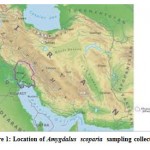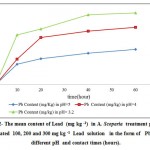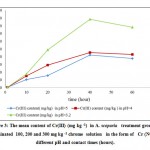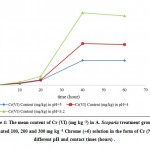Manuscript accepted on : 04 March 2016
Published online on: 21-03-2016
Novel Adsorption Method for Contaminated Water by Wild Endemic Almond: Amygdalus Scoparia
Parisa Ziarati1*, Maryam Moslehishad2 and Fatemehsadat Mir Mohammad-Makki2
1Depatment of Medicinal Chemistry, Pharmacy Faculty, Pharmaceutical Sciences Branch, Islamic Azad University (IAUPS), Tehran, Iran. 2Young Researchers Club, Pharmaceutical Sciences Branch, Islamic Azad University (IAUPS), Tehran, Iran. Corresponding Author Email: ziarati.p@iaups.ac.ir.
DOI : http://dx.doi.org/10.13005/bbra/2017
ABSTRACT: Many of the water systems keep ecosystems thriving and feed a growing human population have become stressed. Water pollution especially heavy metal contamination is a major global problem and it is leading to deaths and diseases. In this study the potential of wild endemic almond: Amygdalus scoparia shell was assessed for adsorption of heavy metal ions such as Pb2+ , Ni 2+ , Cr 6+ and Cr 3+ from aqueous solution. A. Scoparia fruits were collected in July 2014 from Sirmand Mountains near Hadji-Abad County, Hormozgan province and the mountains in Gnow protected area, Bandar-Abbas, Hormozgan province in Iran, respectively. Analyzing of Pb, Ni and Cr (III) and Cr (VI) concentrations performed using Inductively Coupled Plasma-Atomic Emission Spectrometry (ICP-AES). Adsorption capacity of Cr (VI), Cr(III), Pb and Ni onto modified almond shells by phosphoric acid was investigated in a batch system by considering the effects of various parameters like contact time, initial concentrations, pH , temperature, absorbent dose and particle size. The adsorption was pH solution dependent and the maximum adsorption was observed at solution pH of 3.23. Moreover, contents of different heavy metals in the contaminated water showed significant (p <0.05) and positive correlation with contents of Pb (r = +82 to r = +96), Cr6+ (r = +74 to r = +94), Cr 3+ (r = +84 to r = +98), Ni (r = +33 to r = +42) in the waste water and A. Scoparia modified shell, respectively. The amounts of Cr (VI) adsorbed increased significantly with increase in dose of A. scoparia adsorbent (p<0.05) and their contact time (p<0.05). The results of this study revealed that A. scoparia can accumulate high level of lead, Chrome (VI) and (III) in a short time and their uptake rate by plant is significantly affected by their concentrations in the contaminated water (p<0.005). A contact time of 48 hours by almond shell was found to be optimum and 87.1% Cr (VI), 89.8% Cr(III), 84.4% Pb and 48.1% Ni was removed. Experimental results showed that low cost bio-sorbent was effective for the removal of pollutants from aqueous solution.
KEYWORDS: Amygdalus scoparia ;Contaminated Water; Adsorbent; Removal of Heavy Metals
Download this article as:| Copy the following to cite this article: Ziarati P, Moslehish M, Mohammad-Makki F. M. Novel Adsorption Method for Contaminated Water by Wild Endemic Almond: Amygdalus Scoparia. Biosci Biotech Res Asia 2016;13(1) |
| Copy the following to cite this URL: Ziarati P, Moslehish M, Mohammad-Makki F. M. Novel Adsorption Method for Contaminated Water by Wild Endemic Almond: Amygdalus Scoparia. Biosci Biotech Res Asia 2016;13(1). Available from: https://www.biotech-asia.org/?p=7359 |
Introduction
Nowadays one in seven people on our planet, lack access to safe drinking water. More than 40 percent of the planet’s population will be living in areas of “severe” water stress and around 768 million people do not have access to a safe, reliable source therefore water pollution has become to a major global problem and it is leading worldwide cause of deaths and diseases. Pollution of the biosphere with toxic metals has accelerated dramatically since the beginning of the Industrial Revolution [1-3]. Wetland is a water environment which has considerable scientific, economic and social values. They are the habitats of various organisms contributing to the gene cache of microbes, plants and animals on the earth. However, nowadays the pollution and degradation of the wetlands are increasing dramatically [4]. Marine animals can accumulate metals through sea water, suspended particles, sediments and food chains [5]. Permanent contaminants such as metals may be transferred to higher levels in the food chain through environmental expansion. Behavior of trace elements in various weathering environments is dramatically different. In world soil neutral or alkaline weathering environments, U, V, Mo, and Zn have high mobility, while Mn, Pb, Ba, Be, and Bi have low mobility, and Cu, Co, Fe, Ni, Th, Y have very low mobility. Otherwise, in reducing environment conditions As, Ba, Be, Bi, Cd, Co, Cu, Mo, Ni, Pb, Se, Th, U, Zn, V, and Y have a very low degree of mobility [6]. Trivalent chromium occurs widely in nature and is an essentials nutrient required by the human body to promote the action of insulin in body tissues. Chromium as a pure metal has no reported human or environmental toxicity effects. Both acute and chronic toxicity of chromium are mainly caused by hexavalent chromium compounds (Cr VI). Hexavalent chromium is considered the most hazardous of all forms, and in welding fume it is a suspected human carcinogen. DNA damage in welders has been associated with hexavalent chromium exposure [7]. This is consistent with the classification of hexavalent chromium as a human lung carcinogen [8].
Many agricultural by-products such as almond and other fruit or nut shells are available and have low cost. Almond (Rosaceae family) with wide applications in pharmaceutical, oleo chemicals, food and cosmetic industries is considered as a pleasant nut throughout the world. Other than the regular almond, there are more than thirty wild or partially cultivated almond species in the world of which twenty species have been reported in Iran [1, 9]. Iran is the main center for distribution of genus Amygdalus. L . Amygdalus is one of the most problematic genera in family Rosaceae and taxonomy of this genus like many other genera in this family with numerous problems because of high degree of variation in morphological conditions [10]. (Khatamsaz 1993).It shows high degree of variation within one species, high hybridization inter species and high homoplasy under ecological conditions [11].
As Iran is one of the richest countries in the world as regards genetic resources of medicinal and wild unknown plants that some of them are export [12]. We have studied on potential ability of Amygdalus specie as this endemic specie found in some parts of Iran especially in south regions due to accumulate Chrome and Nickel as the major concern in wetland pollution.
Materials and Methods
Study of Area
Almond in areas with warm, dry summers and cold winters and short fall grows well. Distribution Almond mountain areas in Zagros foothills of khuzestan begins and in altitudes 600 to 1500 meters above sea level is located (Figure 1). Around the city of Dezful, Izeh, Baghmalek, Masjed Soleiman and Haftgol abundant of almond can be seen [13]. The Izeh fault zone is a transverse fault zone with dextral strike slip (and some reverse component) in the Zagros Mountains (Iran). It causes some structural deformations. This fault zone is acting as eastern boundary of Dezful Embayment and forms subsidence of the embayment [13]. The Type of regional climate is related to the dry forests and minimum temperature of 18.11 °C and the average temperature of 23 °C and the maximum temperature are 48.5 °C.
Shell samples were washed several times with deionized water and dried (sun or mechanical). The adsorbents were then ground in a blender and stored for further use. All reagents and chemicals were used of analytical reagent grade and were obtained from standard sources.
Phosphoric acid, activated carbon, potassium dichromate and other chemicals were obtained from standard sources.
 |
Figure 1: Location of Amygdalus scoparia sampling collection. |
Characteristics of waste water
To move forward on chemicals management, a project has been done in Pharmaceutical faculty in Tehran-Iran which has 20 laboratories in chemical and toxicological laboratories whose area of work are divided into two types of educational and research. The research has focused on comprehensive environmental management of the poisonings and exposure to toxic and hazardous chemicals especially Lead, Nickel and Cr (III) and Cr (VI). The waste water of inorganic research laboratory was collected during 2 weeks in summer 2015.
Experimental design and Chemical analysis
The shell part of A. scoparia was soaked in phosphoric acid 2% for 24 hours and then dried at 80 ºC in an oven for 24 hours. Dry parts were then ground and weighed. Shell samples (approximately 0.5 g) were digested with concentrated HNO3 and H2O2 [6,7, 25-29 ]. The digested solution was filtered and then analyzed for Pb, Ni and Cr (III) and Cr (VI), concentration using Inductively Coupled Plasma-Atomic Emission Spectrometry (ICP-AES).
Statistical analysis
The values reported here are means of six values. Data were tested at different significant levels using student t-test to measure the variations between the waste water parameters before and after treated by A. scoparia modified shell with waste water. One way analysis of variance (One-ANOVA) was used for data analysis to measure the variations of metal concentrations using SPSS 22.0 software (SPSS Inc, IBM, Chicago, IL).
Results
The mean ±SD values of various physico-chemical and heavy metal characteristics of control (untreated waste water) and treated waste water are presented in Table 1. The results revealed that waste water contained significant quantity of nutrients like Na+, K+, Ca2+, Mg2+, TKN, PO43-, SO42- and heavy metals such as Cd, Cr, Cu, Fe, Mn, Pb and Zn. These are very important parameters that lead to water and soil contamination. The values of various waste water characteristics like TDS (2860.00 mg L -1), BOD (1450.30 mg L -1), COD (3225.00 mg L -1), Ca2+ (650.90 mg L -1), TKN (420.70 mg L -1), Cu (10.36 mg L -1), Fe (16.84 mg L -1), Mn (6.67 mg L -1), Pb (9.64 mg L -1), Zn (18.66 mg L -1), SPC (7.68×108 SPC ml -1) and MPN (8.69×105 MPN 100 ml -1) were recorded beyond the prescribed BIS standards of irrigation water (Table 1). The higher TDS in the waste water is likely due to the occurrence of feacal matter while the more BOD and COD are associated with the presence of higher biodegradable organic waste in the waste water. The higher number of SPC and MPN in the waste water are the indicator of feacal pollution and pathogens. TKN and PO43- were also recorded higher in the waste water and are associated with eutrophication of aquatic ecosystems. Therefore, various parameters clearly indicated that the waste water was highly rich in plant nutrients, heavy metals and contagious.
Table 1: Physico-chemical and heavy metal characteristics of control (untreated waste water ) and treated waste water by A. scoparisa shells after 60 hours
| Parameters | Untreated wastewater by A. Scoparia shell | a Treated wastewater water by A. Scoparia Shell | BIS for irrigation water |
| TDS( mg L -1)
EC(dS m-1) pH BOD( mg L -1) COD( mg L -1) Na+ ( mg L -1) K+ ( mg L -1) Ca2+ ( mg L -1) Mg2+(mg L -1) TKN (mg L -1) PO43- ( mg L -1) SO42- ( mg L -1) Cd ( mg L -1) Cr ( mg L -1) Cu ( mg L -1) Fe (mg L -1) Mn ( mg L -1) Ni ( mg L -1) Pb ( mg L -1) Zn ( mg L -1) SPC (SPC ml -1) MPN(MPN100 ml -1) |
2920.00±5.80
4.50±1.05 6.92±0.55 1450.30±7.88 3436.00±6.00 286.95±4.20 380.70±3.57 650.90±4.65 266.44±3.73 562.56±2.89 120.68±1.28 923.11±2.85 2.86±0.06 11.24±0.02 10.36±1.05 16.84±1.15 6.67±1.04 3.18±0.02 10.47±3.28 24.49±1.11 8.67×108±13 9.11×105±10 |
***180.50±3.64
0.12±0.10 NS6.85±0.36 ***4.20±0.70 ***6.32±1.80 ***10.60±1.15 ***6.33±1.40 ***28.95±2.30 **18.76±2.65 ***33.18±3.76 ***0.33±0.06 *168.94±2.80 ***0.13±0.03 ***1.02±0.01 **2.64±0.12 *3.85±0.04 ***0.48±0.06 *1.08±0.04 ***0.81±0.03 *7.08±2.03 **1.84±×103±3 **2.88×102±11 |
1900
– 5.5-9.0 100 250 – – 200 – 100 – 1000 2.00 2.00 3.00 1.0 1.00 0.2 1.00 15 10000 5000 |
Mean ± SD of six values; a treated wastewater. Significant -***p>0.1 level: **p>0.01% level; *p>0.05 level; NS-not significant.
Chemical analysis
Experimental results showed that the percentage removal Cr (VI) increases with the increasing amount of adsorbent up to 5.4 g for treated shells by phosphoric acid 2%. After this dose of adsorbent no significant change was observed, but for untreated almond shells percentage removal Cr (VI) increases with the increasing amount of adsorbent.
Metal accumulation in shells increased significantly with an increase in applied metal solution concentration in both lead (figure 2) and Cr (III) and Cr (VI), (Figures 3 and 4 respectively) treated groups. In Figures 2, 3 and 4 the mean contents of heavy metals are reported. The metal concentrations remained high in shells in Cr (III) and Cr (VI), treated groups, while lead metal content was higher in treated shells than untreated shells. The ratios of shells/water ratios were calculated to indicate the translocation efficiency of Pb and Cr from water to the adsorbents while for the results of nickel translocation was not significant. The Cr (III) concentrations in samples after 10, 20, 30 and 40 hours are higher in shells than Cr(VI), hence the translocation factor ratios were less than one for Cr (VI) treated samples shows that this method is highly suitable for adsorbing Cr(III) to the Cr (VI). Even though the Cr(VI), concentration of shells of Cr treated samples in 48 hours treated samples is higher compared to controls solutions, the extent of metal accumulation and uptake efficiency of Cr(III) was lower than that of Cr(VI), in long term contaminated situation study. Most of shells in Cr (VI) samples deformed after 60 hours remaining in contaminated water. The effect of adsorbent dose on Cr (VI) uptake was investigated by varying the shell adsorbent dose (1, 2, 3, 4 and 6 g 100 ml-1) for a time interval of 0- 60 hours min (Figure-4).
 |
Figure 2: The mean content of Lead (mg kg -1) in A. Scoparia treatment groups in contaminated 100, 200 and 300 mg kg -1 Lead solution in the form of Pb(NO3 )2 in different pH and contact times (hours). |
 |
Figure 3: The mean content of Cr(III) (mg kg -1) in A. scoparia treatment groups in contaminated 100, 200 and 300 mg kg -1 chrome solution in the form of Cr (NO3 ) 3 in different pH and contact times (hours). |
 |
Figure 4: The mean content of Cr (VI) (mg kg -1) in A. Scoparia treatment groups in contaminated 100, 200 and 300 mg kg -1 Chrome (+6) solution in the form of Cr (NO3 )6 in different pH and contact times (hours) . |
Discussion
The results of present study revealed adsorption capacity of Cr (VI), Cr(III), Pb and Ni onto modified almond shells by phosphoric acid was investigated in a batch system by considering the effects of various parameters like contact time, initial concentrations, pH , temperature, absorbent dose and particle size. The adsorption was pH solution dependent and the maximum adsorption was observed at solution pH of 3.23. Moreover, contents of different heavy metals in the contaminated water showed significant (p <0.05) and positive correlation with contents of Pb (r = +82 to r = +96), Cr6+ (r = +74 to r = +94), Cr 3+ (r = +84 to r = +98), Ni (r = +33 to r = +42) in the wastewater and A. Scoparia modified shell, respectively. The amounts of Cr (VI) adsorbed increased significantly with increase in dose of A. scoparia adsorbent (p<0.05) and their contact time (p<0.05). The results of this study revealed that A. scoparia can accumulate high level of lead, Chrome (VI) and (III) in a short time and their uptake rate by plant is significantly affected by their concentrations in the contaminated water (p<0.005). A contact time of 48 hours by almond shell was found to be optimum and 87.1% Cr (VI), 89.8% Cr(III), 84.4% Pb and 48.1% Ni was removed. Experimental results showed that low cost bio-sorbent was effective for the removal of pollutants from aqueous solution.
According to ATSDR, current evidences indicate that Cr (VI) is a cancer agent only by inhalation. Chronic inhalation studies on mice exposed to airborne Cr (VI) suggest that Cr (VI) is an animal carcinogen [14-15]. The mice developed lung tumors from exposure to 4.3 mg m3 of Cr(VI).However, a number of chronic animal studies showed no carcinogenic effects in rats, rabbits, or guinea pigs exposed to 1.6 mg/m3 of Cr(VI) [14-17]. Thus, cancer effects on animals seem to depend on the type of animal. Eating small amounts of chromium (VI) is not harmful. However, eating or drinking large amounts in food or water can cause an upset stomach, ulcers, convulsions, and damage the kidneys and liver. This type of exposure can be fatal. There is not enough data to know if eating or drinking chromium (VI) causes cancer [14-17]. The results of this study revealed that A. scoparia can accumulate high level of Chrome (VI) and (III) in a short time and their uptake rate by plant is significantly affected by their concentrations in the contaminated water (p<0.005).
The present investigation shows that the almond shells are effective and inexpensive biosorbents for the removal of Cr (VI) from aqueous solutions. The removal of Cr(VI) from aqueous solutions strongly depends on the contact time, initial concentration, pH, temperature, agitation speed, absorbent dose and particle size. The amounts of Cr (VI) adsorbed increased with an increase in dose of both adsorbents and their contact time. A contact time of 48 hours was found to be optimum. The maximum adsorption capacity was obtained at solution pH of 3.2.
A contact time of 48 hours by almond shell was found to be optimum for Nickel adsorbing and 48.1% Ni was removed. Although Ni is required in minute quantity for body as it is mostly present in the pancreas and hence plays an important role in the production of insulin. EPA has recommended daily intake of Ni should be less than 1 mg beyond which is toxic [17]. Ni has been identified as a suspected carcinogen and adversely affects lungs and nasal cavities [18].
This research conduct adsorption of heavy metals by agricultural waste and by-product and proved that this friendly method should gain more attention and research interest for the removal of heavy metals from waste water due to its surface area, adsorption capacity and plenty abundant in nature must be followed seriously.
Also, this research suggests more investigations by other genera and families of cost-effective waste agricultural products applying as adsorbents for these heavy metals and other toxic metals such as cadmium, arsenic and Mercury.
Acknowledgment
Pharmaceutical Sciences Branch, Islamic Azad University (IAUPS) is gratefully acknowledged.
Conflicts of Interest
None of the authors have any conflicts of interest associated with this study.
References
- Nriagu, J.O. Global inventory of natural and anthropogenic emission of trace metals to the atmosphere. Nature J., 1979; 279: 409-411.
- Sayyed, M.R.G., Sayadi, M.H. Variations in the heavy metal accumulations within the surface soils from the Chitgar industrial area of Tehran. Proceedings of the International Academy of Ecology and Environmental Sciences., 2011; 1(1) :36-46 .
- Seifi-Nigje Gheshlagh, F., Ziarati, P., Arbabi Bidgoli, S. Seasonal fluctuation of heavy metal and nitrate pollution in ground water of farmlands in Talesh Gilan, Iran. International Journal of Farming and Allied Sciences. 2013 ;2 (20) : 836-841.
- Dadgar, S., Teimoori, B., Yousefi, S., Tabatabaei, M. Determination of PCB levels in skin and muscle of northern pike (Esox lucius) in Anzali Wetland, Iran. Annals of Biological Research ., 2014; (1): 112-117.Available in site: http://www.scholarsresearchlibrary.com.
- Saghali, M., Baqraf, R., NejatkhahManavi, P., Abbas Hosseini, S., Patymar, R. Assignment of Concentration of Heavy Metals (Cr, Zn, Cd, Pb) In Sediments of Gorgan Bay and South East the Caspian sea (Golestan Province– Iran). Environment and Ecology Research., 2013; 1(2): 27-31. Available in Site: http://www.hrpub.org/download/201309/eer.2013.010201.pdf.
- Abbaslou, H., Martin, F., Abtahi, A., Moore,F.. Trace element concentrations and background values in the arid soils of Hormozgan Province of southern Iran, Archives of Agronomy and Soil Science, . 2014; 60(8): 1125-1143. Available online: http://dx.doi.org/10.1080/03650340.2013.864387 ).
- Sellappa, S.; Prathyumnan, S.; Keyan, K.S.; Joseph, S.; Vasudevan, B.S.; Sasikala, K. Asian Pac. J. Cancer Prev., 2010;11(1): 95–100.
- U.S. Department of Health and Human Services. Report on carcinogens. Twelfth edition, Public Health Service, National Toxicology Program; 2011.
- Kermanshah, A., Ziarati,P., Asgarpanah,J., Qomi, M. Food values of two endemic wild almond species from Iran. International Journal of Plant, Animal and Environmental Sciences. 2014;4(3): 380-388.
- Khatamsaz, M. Rosaceae. In: Flora of Iran . 1992; 6. Research Institute of Forests and Rangelands Publication, Tehran, Iran (in Persian).
- Sayadi, Z., Taheri Abkenar, K., Salehi, A., Ebrahimi, A. An evaluation of the morphologic variety of Amygdalus schoparia branches in Qazvin province, Iran (Case study: Abyek town). European Journal of Experimental Biology, 2012;2 (5):1685-1692.
- Yousefia, M., Olyaei Juybari, E., Yahyapor, M.K., Dehpour, A. A. , Hoseinzade, M. Brine shrimp lethality activity of land and fresh water Medicinal Plants. Advances in Environmental Biology, 2012;6(3): 1196-1199.
- Safari , H., Pirasteh, S., Pradhan, B. . Upliftment Estimation of the Zagros Transverse Fault in Iran using Geoinformatics Technology. Remote Sens. 2009; 1: 1240-1256.doi:10.3390/rs1041240.
- Agency for Toxic Substances and Disease Registry (ATSDR), 2000, Toxicological Profile for Chromium, U.S. Department of Health and Human Services, Public Health Service, ATSDR, September 2000.
- Office of Environmental Health Hazard Assessment (OEHHA), 2001, Public Health Goal (PHG) of 2.5 mg/l for Cr(VI) in Drinking Water is Withdrawn.
- Mance, G. Pollution Threat of Heavy Metals in Aquatic Environment, Elsevier Applied Sciences, New York, NY, 1987, p 372.
- Ziarati ,P . Determination of Contaminants in Some Iranian Popular Herbal Medicines. J Environment Analytic Toxicol., 2012; 2:120. doi:10.4172/2161-0525.1000120.
- Ziarati, P., Behbahani, P., Karbalei Mohammad, N. Role of Unprofessional storage methods on heavy metal contents on Rosa Damascena ( Gole Mohammadi). Journal of Pharmaceutical and Health Sciences .2012;1(4): 73-78.

This work is licensed under a Creative Commons Attribution 4.0 International License.





